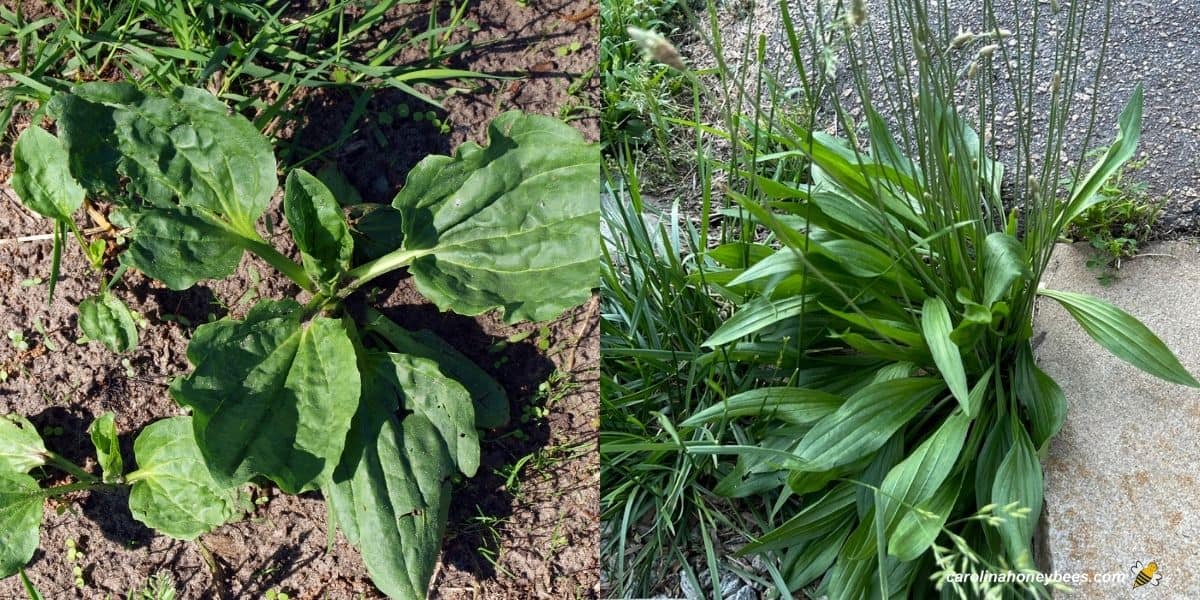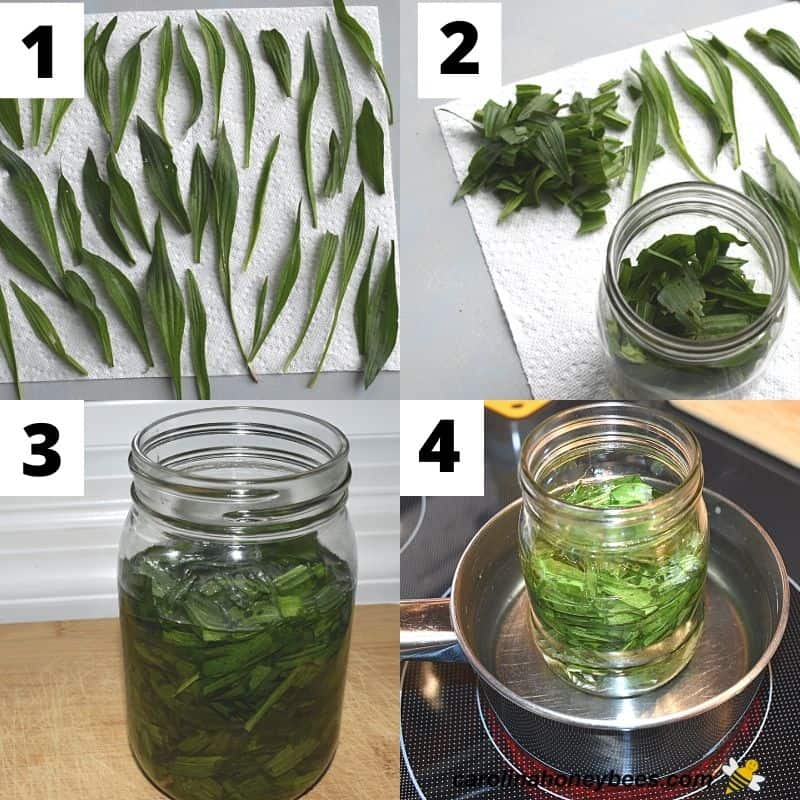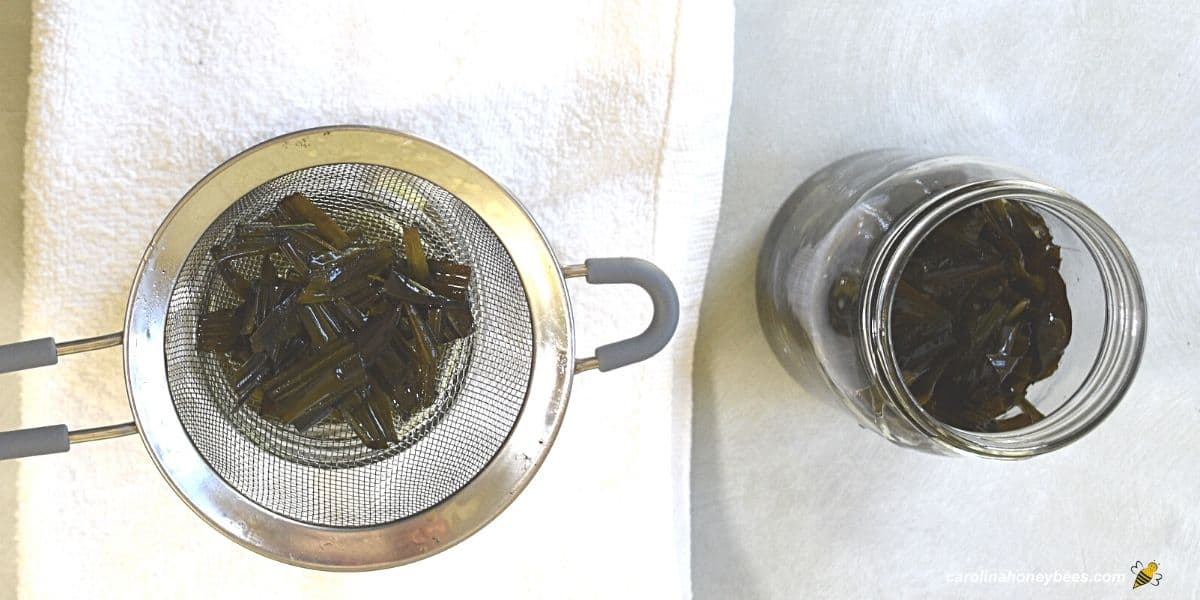DIY Plantain Salve Recipe
Plantain is a common weed that grows in many parts of the world. There are hundreds of species of plantain plants in the genus: Plantago. These weeds are herbal powerhouses that can be combined with raw beeswax and other ingredients to make wonderful healing salves. This tutorial shows you how to make plantain salve right at home.

I’m a beekeeper so I always have a lot of beeswax on hand. A great thing because the uses for beeswax number in the thousands – at least. If you have never tried making herbal plantain salve, now is the time.
Why Use Plantain in a Salve?
Herbalists have long recognized the impressive herbal benefits of plantain. The leaves of the plant have anti-inflammatory, antimicrobial, and skin-soothing compounds. When combined with beeswax in a salve, you can use it for:
- minor scrapes and cuts
- insect bites
- even dry chapped skin
Many beekeepers have been known to make a poultice remedy for bee sting pain. They chew up the leaves (mixing in saliva and apply it to the sting site– covered with a bandage).
Let me personally say – I don’t think it tastes very good this way! Yuck, but it does help soothe the stings symptoms.
Materials You Need
You only need a few ingredients to make plantain salve and no special tools.
- plantain leaves (infused)
- olive oil
- beeswax
- vitamin e oil (optional)
- containers to hold the salve

Plantain
Common plantain is a low growing plant that blooms in late Spring or early Summer and then disappears during Winter. In fact, it becomes more difficult to find fresh plantain as the Summer progresses.
There are two main types of plantain and either can be used for this plantain salve recipe.
- broadleaf
- narrowleaf
Broadleaf plantain (Plantago major) has a rosette shape with broad thick leaves with noticeable veins. When bloom time arrives, greenish brown flowers appear on a tall (9-10”) flower stalk.
Narrowleaf plantain (Plantago lanceolata) is another common variety and is sometimes called English plantain. It has narrower, longer leaves but does have the deep veining. Similar flowers appear on tall stakes from 4-15” tall.
Olive Oil
You will need a small amount of olive oil. You can also use coconut oil if you prefer. Approximately 1 1/2 cup of olive oil is needed – just enough to cover the leaves.
Beeswax
Beeswax is one of the most versatile products from we get from bees. You only need a small amount of beeswax for this salve recipe-but do be sure that the beeswax is clean.
Purchased beeswax pellets are ready to use. Raw wax from your hive or a local beekeeper may need to be cleaned before using it in salves or making beeswax candles.
Vitamin E Oil & Containers
I always add a few drops of vitamin E oil to my salve recipes. It is optional but I feel it helps prevent the oils from going rancid for a longer time. You can simply cut open a few vitamin E capsules and use the liquid.
Containers for your plantain salve can be almost anything with a lid. Small jelly jars or purchased tins – anything with a lid. Do keep in mind that you will be putting your fingers into the container to remove the salve.
Making Infused Plantain Oil
There are two methods for making infused plantain oil to use in your salves.
The slow method involves putting dried leaves in a jar – cover with olive oil and leave them to sit in a sunny windowsill for 4-6 weeks. Fresh leaves can not be used in this way as the moisture in the green leaves will cause spoilage.
For the faster method, fresh leaves will be steeped in the oil for 10-12 hours over low heat. This is the easiest method even though it involves a little bit of time and supervision. I make my dandelion salve in much the same way. You could make both at the same time!
Gather Plantain Leaves
This time I am using narrow plantain. When collecting plants, always be 100% sure of identification. If you have any doubt, ask your local extension or garden center for positive identification.
Harvest plantain leaves in areas that are free of chemicals (such as pesticides or herbicides). Simply pull or cut leaves off the plant. You can refrigerate them for a day or two if you don’t have time to make your infused oil right away.
Infusing Leaves in Oil

1. Gather clean leaves, rinse with water to remove any dirt and let dry.
2. Cut the leaves into inch-sized pieces to allow more surface area for the oils to infuse. Fill a pint jar about 3/4 full.
3. Add enough olive oil to just cover the amount of leaves in the jar.
4. Use a hot water bath to heat the oil. Do not boil – we only want the oil to become very warm. This can be accomplished by heating the water – allowing it to cool down and then heating it again.
I do this for about 8 – 10 hours – just keeping the oil very warm. This is similar to how we decrystallize honey in a jar.

5. After the time has passed, let the infused oil cool down a bit. Then, use a strainer to remove the leaf material. Now, you have plantain infused oil to use for salve making.
How to Make Herbal Plantain Salve

Once the infused plantain oil is ready, it is simply a matter of combining it with some wonderful beeswax and pouring it into a container.

- Gently warm the plantain oil in a double boiler set up
- add the beeswax (measurement below)
- add a few drops of Vit E oil (optional-but always good in homemade salves)
- when all is melted, stir and pour into containers
- when cool add a lid and label
How to Use
This homeopathic medicine is a wonderful addition to your home first aid kit. Simply apply a light coat of salve to minor wounds, rashes, mosquito bites or bee stings – apply a light bandage if needed.
More Ideas
If you want to make more natural products using beeswax, whip up a batch of this salve made with calendula flowers or this honey burn salve– that also contains aloe. All are great to have on hand in case of an emergency.
Other projects I enjoy making: make your own natural vapor rub to ease the congestion of common colds etc.
And, if the idea of rubbing petroleum residues on your skin makes you cringe. Try this easy to make a Vaseline type product with my tutorial on how to make petroleum jelly. Great for simple rashes and minor cuts and scrapes.
*Disclaimer – This information is provided for entertainment only. Anyone can be allergic to anything. Create with care and address any concerns with your medical professional.
Resources:
This post may contain affiliate links. As an Amazon Associate, I earn from qualifying purchases. Please read my disclosure.

Plantain Salve Recipe
This post may contain affiliate links. As an Amazon Associate, I earn from qualifying purchases.
Read my Disclosure.Supplies
- 1 cup plantain infused oil
- 1 ounce beeswax
- 5 drops vitamin E oil (optional)
- 1 piece Tin or small jars to hold 6oz of product
Instructions
- Use a double boiler insert or similar method to melt your beeswax. Take it slow and easy – don't get the wax any hotter than it needs to be.

- Add one cup of infused plantain oil and stir with a wooden skewer or similar. Stir gently until all is blended. Turn off heat. You can add a few drops of Vitamin E oil if you wish – but this is optional.

- Pour into desired container and allow to cool and set. Label your container in some way – it doesn't have to be fancy. That' it!





